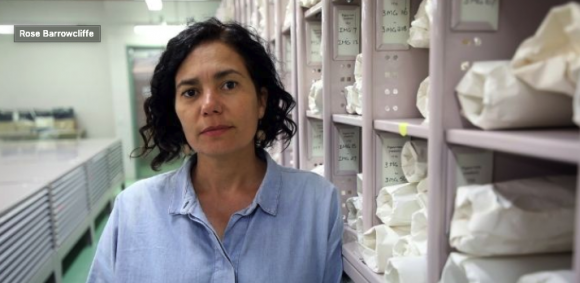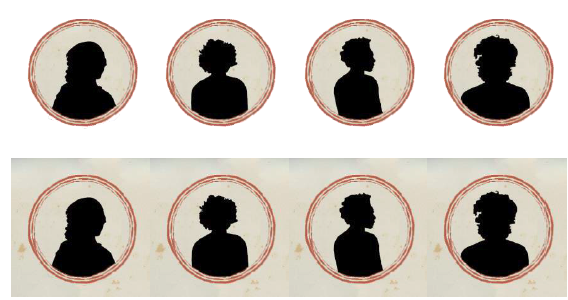Butchulla researcher and artist Rose Barrowcliffe
Rose Barrowcliffe is a Butchulla researcher who is currently undertaking Doctoral Research at the University of the Sunshine Coast (USC). Rose's research examines the representation of Indigenous peoples in archives and how that impacts historical narratives. Her research is grounded in the K'gari Research Archive (held at USC) as an agent of representation of Butchulla history.
In 2021, Rose was appointed as the inaugural First Nations Advisor to the Queensland State Archives. Rose is also a member of the Indigenous Archives Collective (IAC) and the Aboriginal and Torres Strait Islander Data Archive (ATSIDA) reference group.
Artwork 'Aboriginal Archives in Italy'
The net or dilly baskets appear many times in the photos. They are important tools for capturing and storing items in Aboriginal culture. The net in the artwork also represents the capturing and storing of knowledge. The netting also has metaphorical significance because two or more pieces pull against each other, it is that tension that facilitates the function. Just as in the case of these records, there is a tension between the colonial and Indigenous understanding of the records, but that tension can result in a productive outcome. The woven nature of the net also resembles the multiple provenances of these records.
The lines (border and circles) are inspired by the cicatrises of the men in the photos. Cicatrises are a mark of initiation that gives the bearer recognition as a knowledge holder.
The three circles represent 'respect', 'reciprocity', and 'relational accountability'. The circle shape also represents the record continuum.
The colour palette
I drew the colour palette from the eucalyptus tree. I really wanted to include the eucalyptus as a representation of Country. Not only is it present in the photos taken outdoors, but it is also recreated in the studio photos reaffirming how important the landscape is to Aboriginal connection to Country. Further to this, the various parts of the tree represent the record continuum. The roots are Dimension 1, the act, the original event, no part of the tree or record can exist without it. The trunk and bark represent the various actions on the record as it goes through its life. The tree sheds bark seasonally and that reminded me that different people looking at the record at different times will see the tree/record differently. The leaves and flowers travel away from the tree and become part of the larger forest landscape. If you pick up a leaf in a forest you might be able to trace it back to where it came from, but even if you can't it still becomes part of the overall understanding of the environment in which it sits. This is representative of the information in records being used far beyond the original event or even the record. Information in records can inform a larger narrative even if most people never see the original record.
In addition to the eucalypt colours in the palette is the red ochre colour which represents earth and Country. The colour palette also represents the partner archives in Italy. Two of the archives, Castello D'Albertis and the Museo Etnografico “Giovanni Podenzana”, have an ochre-coloured exterior wall very similar to the red ochre in the colour palette and the Museo delle Civiltà has grey exterior walls that are also seen in the colour palette.
Hero Banner
The hero banner has three layers. The beige background is the texture and stain taken from the background of the archival records. Next comes the net built from one of the nets in the photos. Once this piece came together it occurred to me that the net also resembles the shed skin of the carpet snake, or the Rainbow Serpent, an important totem for many Aboriginal peoples. Lastly are the lines which are the cicatrizes. All of these elements have been pulled from the photographic records in the Aboriginal Archives in Italy Digital Archive. The archival paper background does not ever cross or go beyond the cicatriz border, which indicates that archival records, while useful, are limited in their application. They cannot ever take the place of traditional knowledge and lived experience.
Logos
The logos replicate the cicatriz pattern and represent both knowledge and the record continuum.
Elements
The elements show the silhouettes of Aboriginal people that appear in the archival records from the Italian archives. They are protectively surrounded by the cicatriz circle. It was important to me to use silhouettes not the actual image, for two reasons: I wanted to respect the privacy of these people (and their descendants), and the silhouette is indicative of how little is known of these people in the records. We can see their image but know almost nothing about them.
IP and Copyright
These images and elements remain the IP and copyright of the artist. Monica Galassi has permission to use these images and elements for the website and any related non-commercial publications. The artworks may not be used or copied by anyone without the permission of the artist.


